NEONATOLOGY ON THE WEB
Premature and Congenitally Diseased Infants
by Julius H. Hess, M.D.
Part II.
Nursing and Feeding Care
Chapter VIII.
Methods of Feeding.
It is necessary to consider these infants as belonging to two
large groups:
1. Those able to nurse at the breast.
2. Those too weak to nurse at the breast.
INFANTS NURSING AT THE BREAST.
This presupposes that the infant has the proper physical
development to withdraw milk from the human breast in the presence of
an abundant supply and well-developed nipples. Such an infant may be
placed at the breast two or three times during the last half of the
first day after the circulatory and respiratory functions are well
established. Following the first day it should be placed at the
mother's breast regularly for two- or three-minute periods at three-
or four-hour intervals, even though the breast contains little milk.
Following these attempts at nursing, food should be supplied from
another mother or a wet-nurse, whenever such a supply is obtainable
rather than to institute artificial feeding. In the hospital, it is
our custom to give these additional feedings by hand; in private
practice the infant may be placed to the wet-nurse's breast, one of
the breasts being set aside for this purpose, and if there is a
difference in the breasts the better one is selected for the
premature. Whenever possible this is the best method of getting the
food to the baby, as it prevents contamination of the milk,
stimulates the breasts and develops the baby's independence as well
as his sucking muscles. However, it is to be remembered that
congenital syphilis is to be excluded, both in the infant and
wet-nurse, in all cases where the infant is put directly to a breast
other than the mother's. Not infrequently great assistance may be
given the infant in securing its milk by one of two methods: Either
by expressing the milk directly into the baby's mouth or by placing
the wet-nurse's baby on the opposite breast (Fig. 94) which reflexly
stimulates the flow of milk into the opposite breast, thereby assist
ing the weak infant in obtaining its food. Overfeeding becomes
a danger in this direct application of the infant to the breast, and
weighing before and after nursing should be practised.
Underfeeding is an even greater danger, and here again. the
infant must be weighed before and after feeding to ascertain the
amount of food taken. If insufficient, further food can be supplied
by hand feeding.
INFANTS TOO WEAK TO NURSE AT THE BREAST.
In this group of infants careless exposure must be avoided. In the
absence of cyanosing they may be fed without removal from the bed. If
cyanosis threatens they should be fed on the dressing table. The
inability to nurse may be due to improper development of the nursing
center, or lack of coordination on the part of the pharyngeal muscles
and tongue. The latter is usually made evident by a return flow of
milk from the mouth. Again, the infant may be too weak to nurse, or
it may not have learned to suck, or vomiting or perhaps cyanosis may
prevent its feeding properly. In this group of infants we may, of
necessity, resort to one of several procedures:
The use of a fruit spoon (Fig. 95) or, better a large size
medicine dropper (Fig. 96).
In those infants who can assist themselves:
A small nursing bottle (Fig. 97). The 1-ounce bottle is
provided with small nipples the size of those commonly sold on doll
nursing bottles, which can usually be obtained of proper quality.
Such a nipple can be made by perforating the rubber bulb of a better
quality medicine dropper. Our 2-ounce bottle has a larger neck which
takes the ordinary size nipple. One with a small mouth piece must be
used. It should be made of a soft elastic rubber. The semitransparent
nipples usually answer best on the soft rubber tube when inserted
into the mouth. When sufficiently developed a small bottle and nipple
can be substituted.
The Breck feeder in the original, or a modification which
can be made by flanging the ends of a urethral syringe, using a heavy
rubber finger-cot on one end and a small nipple or perforated soft
medicine-dropper tip on the other, will usually suffice (Fig. 98).
The second type illustrated has the disadvantage of having the milk
enter the bulb on filling from the large end. The bulbs are difficult
to clean.
Direct expression of milk into the infant's mouth has
proved one of the most valuable expedients in our hands as a
method of teaching the infant the act of nursing.
Catheter feeding is the simplest and best method of
procedure in the smaller infants, if carefully practised by an
experienced nurse, Catheter feeding should be instituted as soon as
fatigue or cyanosis is noted following other methods of feeding. A
catheter (No. 12 French, No. 8 American, No. 5 English) about 14
inches in length may be attached to a small funnel, graduated glass
tube, or, in case of emergency, the glass barrel of a small syringe
may be used. , All food should be carefully measured and administered
slowly with a minimum elevation required to obtain a free flow
of the milk. The infant should be upon its back on a flat surface
with the head either in the median line or turned to the right. The
passage of the catheter is usually effected without difficulty by
passing it in the midline to the pharynx, gradually pushing it into
the esophagus. The poorly developed reflexes rarely cause retching.
The distance to which the catheter is to be passed is of great
importance when we consider that this procedure must be repeated at
least six to eight times daily over a considerable period of time. It
has been our rule to measure the distance from the bridge of the nose
to the tip of the ensiform cartilage, which is usually in the
neighbor hood of 12 to 15 cm. (Full-term new-born infants average
about 16 cm.) The catheter is marked at this point with indelible ink
and is passed to this point or about 1 cm. further than this distance
which allows it to reach the lower end of the esophagus just above
the cardia, from which point the food will flow through the patent
cardia. We thereby avoid irritating the gastric mucosa and
stimulation of the reflexes at the cardia. One soon learns the
distance the catheter can be passed in each case in order to avoid
retching. The milk is now allowed to flow into the stomach slowly,
the funnel being raised only slightly above the level of the body,
usually 6 or 8 inches will suffice. After the feeding the catheter is
firmly compressed to avoid spilling milk into the pharynx during its
removal (Figs. 99, 100 and 101).
The infant should be turned on its right side following the
feeding. In the presence of gastric distention, raising the infant
before and after feeding to the vertical position, avoiding flexion
of the body, will allow of the eructation of air and frequently
prevent cyanosis. When the stomach" is noticeably distended with gas
before feeding the catheter should' be passed 1 or 2 cm. further than
the mark on the catheter before starting feeding, in order to allow
the gas to escape. It is then retracted as directed and feeding
started. The catheter should be passed with the funnel empty, so as
to allow of this procedure. The catheter should then be compressed
and the milk poured into the glass funnel. This allows the air in the
funnel to escape thereby preventing overdistention of the stomach by
the mixture of food and air. The feeding period should be as short as
possible without undue haste. Too rapid feeding is more dangerous
than too slow. Usually one to three minutes are needed. Two nurses
can be used to advantage in catheter feeding, but, as so frequently
happens, only one is available during the night feedings. Every nurse
should be trained to undertake catheter feedings with out assistance.
We believe that turning the infant on the right side following
feedings reduces the emptying time. Its position should be changed at
least once between feedings to avoid localized pulmonary congestion.
The Number of Feedings:-This will, of necessity, depend in
many instances upon the question of catheter versus other methods of
feeding. Larger infants fed by catheter can often be given sufficient
food at four-hour intervals to meet. their needs. In small infants
fed by dropper, bottle or other methods we have experienced great
difficulty in administering a sufficient quantity of food by the
long-interval feeding. As the attendants in charge are frequently not
to be trusted with the catheter feeding, the short-interval feeding
must be resorted to.
For this purpose we have grouped our infants into two classes --
those weighing under 1500 gm. and those weighing above this figure.
These figures are arbitrary and will not require rigid adherence. The
classification is based on the tendency of the smaller infants to
become exhausted when the feedings are too long continued. The
smaller hand-fed infants are fed at two-hour intervals during the day
and three hours at night. The larger on the three-hour basis. When
catheter feeding is the method of choice, even in the smaller infants
six to eight is usually the maximum number needed in twenty-four
hours. It must be remembered that all feedings are dependent on the
general development of the infant in relation to its digestion and
metabolism and its ability to retain the food administered, as well
as on the attendant complications to feeding, such as asphyxia,
cyanosis and gastric distention.
When to Start Regular Feeding.-This is a question of great
importance to these infants, because of the tendency to develop acute
inanition. Therefore a regular feeding regimen must be started early.
Human milk is essential to a low mortality. As little can be expected
from the mother for several days, it becomes necessary to obtain the
limited supply necessary from another mother, preferably a wet-nurse.
If for any reason it is unlikely that the mother may be depended
upon, either because of illness or local breast conditions, immediate
search should be begun for a supply of breast milk.
Feeding During the First Day.-During the first day it is
our custom to withhold milk for twelve hours until the respiratory
and circulatory functions are well established. During the second
twelve hours one to three feedings of breast milk may be started if
the infant's' condition warrants.
Feeding from the Second to the Tenth Day.-The second to the
tenth days may be grouped together as the second feeding period for
practical purposes.
From the second day they should be fed regularly, day and night,
the number and time of feedings depending to a great extent on
whether the food be given with or without the use of a catheter;
second, upon the gastric capacity; third, upon the infant's general
condition.
Further fluids, preferably inert, such as water or 1 per cent
lactose solution, are administered to compensate for the loss of body
fluids through the kidneys, bowels, lungs and skin. The infant
requires about one-sixth of its body weight of water, inclusive of
that contained in the milk, in twenty-four hours while in the heated
bed. Such quantities, however, should not be attempted on the first
days; usually it will be possible to approximate one eighth of the
body weight by the fourth day. The early feedings must necessarily be
small and the increases gradual.
Each Infant Fed Individually.-They must be considered
individually, as it is impossible to formulate definite rules for
feeding, at least during the first ten days.
1. We must have a definite idea of the minimum food
requirements for life.
2. The amount of food necessary to maintain at least a
stationary weight.
3. The amount of food needed to, meet the requirements for
growth and development.
Approximately one-seventh of the body weight of fluids and human
milk of a food value of 70 calories per kilo every twenty-four hours
are required to maintain life. Little can be expected in the way of
weight increase until 90 calories are reached, and depending on their
weight, body surface and physiological development, their later needs
will approximate 100 to 140 calories per kilo body weight (Table IV).
In exceptional cases it may be necessary to feed breast milk in
amounts equaling 160 to 200 calories per kilo. Such infants are
usually markedly underweight for their fetal age.
Infants, to fulfill all their needs, will therefore require from
140 to 200 cc of breast milk per kilo, or about one-seventh to
one-fifth of their body weight daily. They can, however, maintain
life, on 100 cc and hold their weight in most cases on 130 cc per
kilo. Exceptionally, we have fed as high as 300 cc per kilo in
underweight infants. The latter must be carefully observed for signs
of overfeeding, such as vomiting, gastric dilatation and cyanosis:
Beginning (in most cases by the second day) with 20 to 40 cc human
milk per kilo of body weight, the quantity may be increased by 8 to
15 cc daily per kilo until, usually by the tenth day, feedings
averaging from 80 to 140 cc per kilo can be fed (Tables I, II and
III).
AVERAGE HUMAN MILK DIETS REQUIRED BY
PREMATURES DURING THEIR FIRST TWENTY-ONE DAYS.
After the tenth day in larger infants the milk can be
increased more rapidly, usually by 15 and occasionally 20 cc per day,
until from 140 to 200 cc (100 to 140 calories) per kilo are fed, the
methods of giving food, as well as its frequency being dependent on
the general development of the infant.
The size of individual feedings will vary with the method of
feeding. When catheter fed, six to eight feedings a day are
given, with an average of from 4 to '6 cc per feeding during the
second day. The feedings are now increased daily by an average of 2
cc per feeding. When feeding from the bottle or by dropper,
smaller feedings are usually given more frequently-usually from
eight to ten daily, although twelve may be needed when larger
feedings are not retained. Begin with 2 to 4 cc and increase by 1 or
2 cc per feeding on each succeeding day, until 140 to 200 cc per 1
kilo per day is reached.
The food and water to be administered should be noted in writing
for the nurse's instruction each day, after a thorough inspection of
the infant and its clinical chart.
The diet of a premature infant making a satisfactory gain in
weight should not be changed arbitrarily without a well-defined
indication.
These feedings should, as rapidly as possible, be supplemented by
water or sugar water by mouth, or saline by rectum to meet the
required 140 to 200 cc per 1 kilo of fluids required daily.
Initial Weight Loss.-The lower the birth weight, the
greater is the percentage weight loss to be expected.
Artificially-fed infants lose more weight than breast-fed infants in
whom the diet is started early. An average loss of not more than 8 to
12 per cent of the birth weight may be considered as satisfactory. By
regular administration of inert fluids during the first days the
total loss can frequently be reduced to 5 per cent.
Daily Gains.-These are not necessarily in. proportion to
the changing quantity of milk administered, as many factors, such as
condition of the bowels, quantity of urine passed, temperature of the
infant's surroundings and numerous other factors will necessarily
influence the weight.
An average daily gain greater than 20 gm is unusual when the
infant's food is. limited to one-sixth of its body weight.
Although occasionally an infant holds its birth' weight, most
infants do not. regain their birth weight before the end of the
second or third week.
In the very small prematures an average daily gain of 10 to 15 gm.
with a doubling in birth weight in from seventy-five to one hundred
days may be considered satisfactory. In the larger infants a gain of
15 to 20 gm. may be expected with a doubling in birth weight in from
fifty to one hundred days. The birth weight is frequently trebled
within one hundred and eighty days.
Special Feeding Rules.-1. Food requirements which have been
recommended must, of necessity, be considered as relative, variations
being to a great extent influenced by the physiological and
anatomical developments and to a not inconsiderable extent by the
temperature and humidity of the air surrounding the infant and the
type of clothes in which it is dressed.
2. Each day the total amount of food as indicated for the
individual infant is to be estimated, in order that the required food
and water will be administered. The number and amount of feedings
will, of necessity vary, but each must also be estimated for each
day.
3. When a number of infants are to be fed by one wet-nurse,
careful calculation of the day's needs of each infant must be made by
the floor nurse for the information of the nurse in charge of the
milk supply.
4. Expression of breast milk should be performed at regular
intervals, preferably six times a day at four-hour periods day and
night. The sixth expression during the night may, however, be omitted
if the supply is in excess. It is only by regular and complete
emptying of the breasts by expression that a milk supply can be
maintained for an indefinite period, unless there is a second baby
which can be placed at the breast.
5. Human, as well as cows' milk, must be obtained under aseptic
conditions and kept clean and cool until ready for the infant. To
preserve milk properly, the ice box must register less than 50°
F. The food should be slowly warmed before feeding.
6. The boiled water to be fed must be carefully calculated, and it
must represent the difference between the total fluids indicated
which will usually average from one-eighth to one-fifth of the body
weight of the infant for twenty-four hours and the amount of fluid
given as milk. The water for each day should be measured and set
aside in an individual stoppered bottle each morning.
It should be administered between the milk meals or occasionally
there may be an indication for diluting the milk with part of it. In
order to administer the full day's water supply in some of the small
infants and those who vomit, it may be necessary to give water in
small quantities one, two and even three times between milk feedings.
If unable to swallow properly water must be given by catheter. In
larger infants only a few water feedings a day may be needed, and
usually by the third or fourth week, one-seventh or one-fifth of the
body weight in milk can be fed daily. At this time the water may be
discontinued unless it is necessary to supply external heat of
considerable degree, or the infant has a fever, both of which
necessitate increased amount of fluids.
The maximum feeding figures as given in the tables for 1000-,
1500- and 2000-gm. infants from the seventeenth to the twenty-first
days and which range from 140 to 161 calories may seem excessive, but
it should be remembered that in figuring these feedings they are
based on birth weight without allowance for weight increase which is
usually seen during the third week of life of these infants.
Allowance for these weight increases are covered by the maximum total
diet recommended. Not infrequently the infant requires more rapid
increases in its diet than those quoted as the maximum feedings. The
physician must be the best judge of the needs of the individual case.
Feedings After the Twenty-first Day.-Usually by the
twenty-first day, the food requirements of the infant are quite well
established and a careful observation of the infant's weight, stools,
disposition and equally important, its body temperature will decide
the future food requirements.
The water requirement will, to a great extent, be dependent upon
the supply of artificial heat and the presence of fever. Ordinarily
by the beginning of the fourth week, one-seventh to onefifth (140 to
200 cc or 100 to 140 calories per kilo) of the infant's body weight
in the form of breast milk is needed to maintain proper growth.
Occasionally it is necessary to exceed these amounts in the poorly
nourished premature. If the physiological functions are seemingly
normal the scale is the deciding factor in indicating food
increases or decreases.
As the infant takes on weight and becomes fat with a rounding of
the features and the body as is the case in successfully
breastmilk-fed prematures, the total milk administration can be held
at one-sixth and not infrequently one-seventh of the body weight, and
normal weight increases may still be maintained.
Mixed Feeding.-When human milk, even though in small
quantities, is available, it should form the basis of the diet, and
cows' milk mixtures should be supplemental (Cases 1 to 14).
Experience has taught us to expect a rapidly increasing mortality
when less than 50 per cent of the food is other than human milk.
ARTIFICIAL FEEDING.
There can be no comparison between the results to be expected in
feeding premature infants on human milk and those to be obtained with
artificial food. This is especially true of infants with a weight
below 1500 gm. Therefore, if it becomes necessary to resort to
artificial feeding,. the selection of a food, its preparation, and
its adaptation to the infant must all be given the most painstaking
consideration. Many varieties of artificial diet have been suggested
by many different authors, such as simple milk dilutions cream and
top-milk mixtures, skimmed milk and buttermilk preparations, malt
soup preparation, condensed and evaporated milk, etc. The results
with these various diets are to a great degree dependent upon the
physician's intimate understanding and directions for the use of the
individual food (Fig. 129).
Quantity of Food.-It must be remembered that the figures
quoted for the feeding on breast milk are the maximum that can be
assimilated and are excessive quantities for artificial feeding in
the first weeks of life because of greater difficulty in the
digestion of cows' milk. These infants when artificially fed must at
all times be closely watched for evidences of overfeeding, and the
first evidence of digestive disturbances or of intercurrent
infections should lead to the feeding of human milk whenever
possible.
From the foregoing statement, it is quite evident that smaller and
slower weight increase may be expected of the artificially fed.
Quality of Food. -- As previously stated, opinions vary
greatly as to the best food for artificial diet. Most clinicians have
obtained the best results with the feeding of low-fat mixtures.
Boiled milk, skimmed milk and buttermilk, with carbohydrates added,
are among the best.
In feeding with buttermilk and skimmed milk with added
carbohydrates, the fat-free mixtures must not be too long continued,
otherwise the infants will suffer from fat inanition. By the end of
the third week some whole boiled milk may be added or the lactic-acid
milk should be prepared from partly skimmed milk. It is our routine
to boil all artificial food mixtures for at least two minutes.
In feeding with a buttermilk high carbohydrate mixture, the
caloric requirements are lower than in feeding with the full milk
(chymogen) mixture with its lower carbohydrate content,
because the energy for digestion and assimilation requirements are
lower with high-carbohydrate low-fat feeding as compared with
high-fat low-carbohydrate mixture.
BUTTERMILK AND SKIMMED MILK MIXTURES.
|
Buttermilk or skimmed milk
|
1000
|
|
Flour (dextrinized)
|
10
|
|
Sugar (cane)
|
40
|
The above being used for the first weeks.
|
Buttermilk or skimmed milk
|
1000
|
|
Flour (dextrinized)
|
15
|
|
Sugar (cane)
|
60
|
For later feedings, Maltose-dextrin compounds can be substituted
for the cane sugar if desired.
Directions for Preparation.-Add the flour to a few
tablespoonfuls of buttermilk or skimmed milk and rub to a paste. Add
butter milk or skimmed milk to 1 liter.
Bring mixture to a boil and withdraw from the fire.
Add the sugar and bring to a boil for the second time.
This process should require about twenty minutes.
Make up to 1 liter with boiled water.
Keep on ice.
In the use of the buttermilk mixture it must be remembered that
infants are not to be kept on this low-fat mixture for too long a
time, addition of whole milk being indicated after the first few
weeks, beginning with one-third whole milk and two-thirds skimmed; by
the fourth week equal parts whole and skimmed milk should be used in
the preparation of the lactic acid milk.
Chymogen Milk
Requirements for Preparation.
Milk.
Single boiler, 1- or 2-quart.
Dairy thermometer.
Chymogen powder (Armour & Co.).
Teaspoon.
Egg beater.
Directions for Preparation.-Boil milk for five
minutes over direct flame, cool to 104° F., and add one full
teaspoonful of chymogen to each quart of milk, and stir for one-half
minute. Let it come to a clabber by allowing it to stand for fifteen
minutes, holding it as near 100° F. as possible by keeping it in
a warm place; then beat it well until the curd is finely divided. Put
it in individual feeding bottles and place on ice. Do not heat above
1000Y. -when preparing individual bottles for feeding,
otherwise curds will clump and will not pass through the nipple.
Reheating is best accomplished by placing the individual feeding
bottle in a cup of warm water not over 115° F. and allowing it
to stand for ten minutes. Replenish the warm water if necessary.
We have found this predigestion of boiled milk, by the addition of
rennet (chymogen) assures the infant's stomach of a fine, flocculent
curd, which is about the size of that of human milk. In beginning
feedings with the above preparation it is usually diluted with 3
parts of water and increases in quality made as indicated, and the
quantity increased as in the feeding of human milk. In feeding with
the diluted predigested milk, 15 gm. (1/2 ounce) of lactose should be
added to each liter during the first few days, and the amount
gradually increased to 30 gm. (1 ounce).. When chymogen is not
available, whole milk boiled for five minutes may be used.
In the feeding of these food mixtures the relative caloric values
of the mixtures as compared with breast milk must be borne in mind,
otherwise inanition will be the result.
Human milk equals 700 calories per liter or 21 per ounce.
Skimmed milk or buttermilk mixture containing 10 gm. dextrinized
flour and 40 gm. sugar per liter equals 16 calories per ounce or 525
per liter.
Chymogen milk (whole milk) equals 700 per liter or 21 per ounce.
Chymogen milk when diluted with 3 parts water and 15 gm. of sugar
per liter equals 235 calories per liter or 7 per ounce.
Chymogen milk when diluted with equal parts water and 30 gm. of
sugar per liter of .mixture equals 470 per liter or 14 per ounce.
Each individual ounce of sugar per liter of mixture increases its
food value by 4 calories per ounce. Rarely should more than 2 . ounce
of sugar be added for each liter of the mixture, which represents an
addition of 8 calories (6.5 per cent) of carbohydrate to that already
contained in the milk. ' It is, therefore, of the greatest importance
that the milk itself either skimmed, buttermilk or whole be increased
gradually along with the sugar.
Amounts to be Fed.-Depending upon the weight and
development of the infant, the tables as given for human milk feeding
should be followed. It must be remembered that while the artificial
diets recommended have a lesser caloric value per cc than human milk,
they represent for most infants the maximum capacity for digestion
and assimilation. Of necessity, lesser weight increases and slower
progress are to be expected. The infants are paler, tissue turgor is
lacking and they are less immune to infection.
Other Dietetic Requirements.-To counteract the effects of
boiling, orange-juice feeding should be instituted by the third week,
beginning with 0.5 cc (8 drops) and increasing 2 to 4 cc (1/2 to 1
dr.) daily by the eighth week, in order to avoid scurvy. Cod-liver
oil as an antirachitic should be fed by the fourth week, beginning
with 0.5 cc (8 drops) daily divided into two feedings and increased
to 2 cc (30 drops) daily by the eighth week. It may -be mixed with
the orange juice. To counteract the low iron content of these diets,
carbonate of iron in 0.03 gm. (gr. 1/2) or citrate of iron and
ammonia in 0.03 gm. (gr. 1/2). once daily should be started by the
fourth week. The latter may be prescribed in solution.
Mixed Diet.-These food additions apply for breast-fed as
well as bottle-fed infants:
Fifth month, a little well-cooked cereal may be added to one of
the meals (begin with one teaspoonful), adding it to the bottle of
milk.
At the sixth month, infants readily take a broth and vegetable
meal as a substitute for one of the milk feedings, in the form of a
vegetable and meat soup. Begin with one ounce and follow by a second
bottle containing the milk mixture with one ounce less than full
feeding. Gradually replace an entire milk feeding. `.
Ninth month, a vegetable soup or a clear broth (chicken, lamb or
veal), and toast or zwieback crumbs, with an additional portion of
stewed fruits (apples, prunes) or a strained vegetable (spinach,
carrots or turnips). The broth is usually given in the same quantity
as the bottle, if given alone, or somewhat less if either the
vegetable or fruit is given in addition.
Cereal.
Two tablespoons of cereal.
One-half pint of water and one-half pint of milk. One pinch of
salt.
Cook in double boiler for one hour.
Begin feeding one and a half tablespoonful, gradually increasing
to two tablespoonfuls.
Add the cereal to the milk mixture or pour part of bottle over the
cereal and feed with a spoon. Finish the meal with remainder of the
bottle.
Toast or zweiback (one-half slice crumbed) at about the eighth
month.
Vegetable Soup.
Lean lamb cut into small pieces (4 lb.). One potato.
One carrot.
Two stalks of celery.
One tablespoonful of pearl barley.
Two tablespoonfuls of rice.
Two quarts of water.
One pinch of salt.
Finely divide the vegetables. Add the vegetables barley and rice
to two quarts of water. Boil down to one quart, cooking three hours.
Add pinch of salt. Pass through fine sieve.
Begin feeding one ounce, gradually increasing to eight ounces,
cutting out an ounce of milk mixture for each ounce of soup given.
When less than a full feeding is fed finish the meal with sufficient
milk mixture, from a second bottle, to make a full feeding.
|
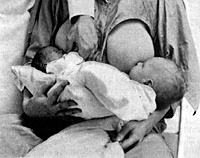
|
Fig. 94.-Feeding premature infant by direct expression
from right breast. Wet nurse's baby on left breast assists
in stimulating the flow of milk into the right breast.
|
|

|
Fig. 95.-Fruit spoon which can be used for mouth or nasal
feeding. The latter is not recommended.
|
|

|
Fig. 96-Large medicine dropper with a short piece of soft
rubber tubing over lower end to prevent injury to the baby's
mouth. Most infants soon learn to suckle.
|
|
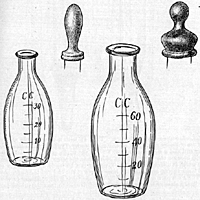
|
Fig. 97.-One ounce graduated nursing bottle with small
nipple approximately the size of the end of an ordinary
medicine dropper. Two ounce graduated bottle with a special
nipple with a small mouth piece. This nipple will fit on the
larger neck bottle sold on the market and can also be
inverted for cleansing. Another good nipple is that shown in
type two Breck feeder. (Fig. 98.)
|
|
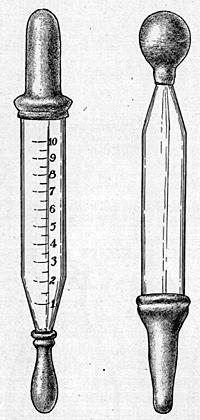
|
Fig. 98.-Modified Breck Feeders. Type I: with a small
nipple at the lower end and an ordinary finger cot at the
upper end. Type II: has a large nipple at the lower end and
a medicine dropper bulb at the upper end. The latter is not
a safe model because the milk must be poured into the large
end and therefore enters the bulb which is difficult to
clean. Type III can be made by flanging a straight piece of
large tubing and using the large nipple at one end and the
finger cot at the other. The glass part can be blown by any
specialty glass company or the barrel of an ordinary
glass syringe can be drawn and flanged to take the rubber
parts.
|
|
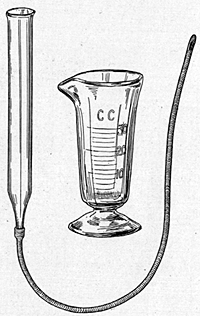
|
Fig. 99.-Utensils for catheter feeding. Glass barrel of
syringe, No. 12 French catheter and one ounce graduate
glass. The catheter should be marked at 2 em. intervals
between the distances 12 to 20 cm. above the tip.[1]
|
|
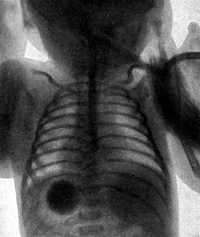
|
Fig. 100.-Catheter feeding. The catheter has been passed
for a distance equal to that from the bridge of the nose to
the tip of the ensiform cartilage measured with the chin at
right angles to the body.
|
|
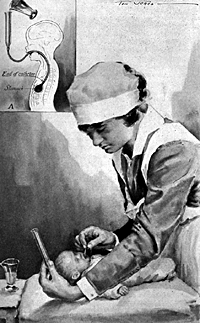
|
Fig. 101.-Feeding baby with catheter. Catheter feeding as
carried out by one person. The head is held at right angles
by the left hand, the catheter is passed with the right
hand. Next the funnel is passed to the left hand and
elevated to allow the air to escape from the stomach. The
catheter is now compressed and slightly elevated and part or
all of the feeding is poured in from the graduate and
allowed to flow slowly into the stomach. The small sketch
illustrates the point to which the lower end of the
catheter, should be passed.
|
|

|
Fig. 102.-Baby Juanita. Age, one day; weight, 1070 gm.
|
|
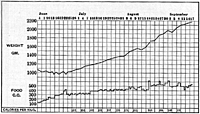
|
Fig. 103.-Baby Juanita. Weight and food curves and
calories per kilogram weight. The patient entered June 4,
aged one day; weight, 1070 gm.; condition fair. Discharged
September 18; aged one hundred and five days; weight, 2180
gm. An ideal curve with an energy quotient ranging between
132 and 170, and an average daily gain of 12.5 gm. over a
period of ninety days.
|
|
|
Fig. 104.-Baby Silvis B. Age when taken, seven months;
weight, 13 pounds.
|
|
|
Fig. 105.-Baby Silvis (Italian). Weight and food curve
and calories per kilogram. Born July 5, admitted July 8;
weight, 1050 gm.; lowest, weight, 980 gm., on his tenth day
of life. Initial loss, 70 gm. Discharged September 11; aged
sixty-five days; weight, 1580 gm. Regained entrance weight
fourteenth day in hospital when seventeen days old.
|
|
|
Fig. 106.-Baby Allen B. Age, eight days; weight, 1135 gm.
|
|
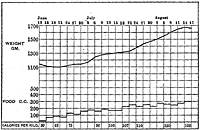
|
Fig. 107.-Baby Allan B. Weight and food curves and
calories per kilogram. Born June 5; admitted June 12; weight
1135 gm. Discharged August 16, weight, 1655 gm.; age,
sixty-four days. Regained entrance weight fifteenth day in
hospital Initial loss = 35 gm.
|
|
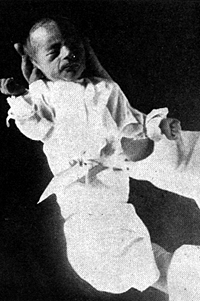
|
Fig. 108.-Baby Peggy. Age, three days; weight, 1185 gm.
|
|

|
Fig. 109.-Baby Peggy. Age, forty-three days; weight, 2155
gm.
|
|
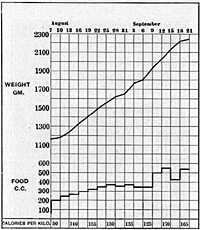
|
Fig. 110.-Baby Peggy. Weight and food curve and calories
per kilogram. Admitted August 7; weight, 1185 gm. Discharged
September 19; weight, 2155 gm.; age, forty-three days. No
initial loss.
|
|
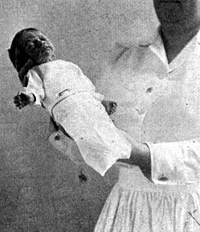
|
Fig. 111.-Baby Grace A. Age, three days; weight, 1180 gm.
|
|
|
Fig. 112.-Baby Grace A. Age, eighty-nine days; weight,
1875 gm.
|
|
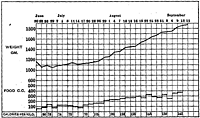
|
Fig. 113.-Baby Grace A. Weight and food curve and
calories per kilogram. Born June 17, admitted June 20;
weight, 1180 gm. Discharged September 14; weight, 1875 gm.;
age, seventy-seven days. Regained entrance weight
thirtysixth day in hospital, Initial loss, 110 gm.
|
|
|
Fig. 114.-Peter P. Taken when sent home. Weight at birth,
1220 gm.; weight when sent home, 2810 gm.
|
|
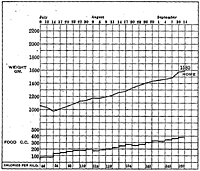
|
Fig. 115.-Baby Peter P. Weight and food curves and
calories per kilogram Born May 26, admitted May 26; weight
1175 gm. Discharged September 11 weight 2480 gm.; age, one
hundred and eight days. Regained entrance weight on
thirty-second day in hospital, when thirty-two days old.
Initial loss = 220 gm. Double birth weight in one hundred
days.
|
|
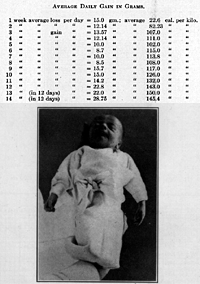
|
Fig. 116.-Ethna H.
|
|

|
Fig. 117.-Baby Ethna H. Showing weight and food curves
and calories per kilogram weight. The patient entered the
hospital July 9, aged one day; weight, 1360 gm.; condition
fair. Discharged October 5; aged eighty-eight days; weight,
2512 gm. Showed a steady increase after 137 calories was
reached and continued to grow steadily until 220 was fed.
The growth averaged only 13 gm. daily, being lower than
several infants fed with a much lower energy quotient.
|
|
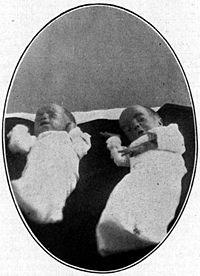
|
Fig. 118.-Joseph and Edward R. (twins). Age, three days.
Birth weight: Edward, 1360 gm.; Joseph, 1190 gm.
|
|
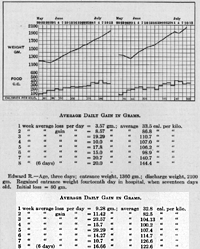
|
Fig. 119. -- Baby Joseph R. and Baby Edward R. (twins).
Born May 17, admitted May 20. Discharged July 13; age, sixty
days. Mother died third day after labor. Joseph R.-Age,
three days; entrance weight, 1190 gm.; discharge weight,
1950 gm. Regained entrance weight on twelfth day in
hospital, when fifteen days old. Initial loss = 40 gm.
Edward R.-Age, three days; entrance weight, 1360 gm.;
discharge weight, 2100 gm. Regained entrance weight
fourteenth day in hospital, when seventeen days old. Initial
loss = 80 gm.
|
|
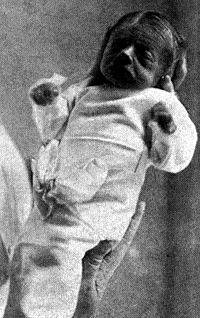
|
Fig. 120.-Baby Grace B. Taken at admittance. Birth
weight, 1395 gm.
|
|
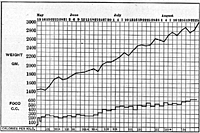
|
Fig. 121.-Baby Grace B. Weight and food curves and
calories per kilogram weight. The patient entered May 13.
Age, one day; weight, 1440 gm.; condition fair. Discharged
August 27, aged one hundred and six days; weight, 2960 gm.
Showed initial gain on 102 calories, followed by a loss when
the same was reduced below 100; followed by a gain at 100,
and a steady loss at 91; a moderate gain at 109; the loss
was again repeated at 90.5 and was followed by a rapid gain
at 130 to 137, averaging daily 24.5 gm., and a less rapid
growth, with greater fluctuations, at 115 to 109.5,
averaging 10 gm. daily and again rapidly rising with 124.
|
|
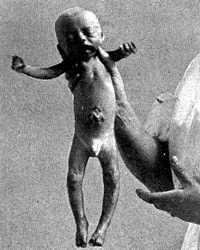
|
Fig. 122.-Baby Glenn. Age, two days., One of twins. Other
twin died on first day.
|
|

|
Fig. 123. -- Baby Glenn. Age, one hundred and eight days.
|
|

|
Fig. 124. -- Baby Glenn. Age, five years.
|
|
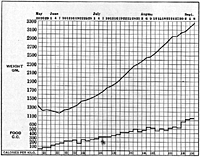
|
Fig. 125.-Baby Glenn. Weight and food curves and.calories
per kilogram. Admitted May 23; weight, 1340 gm. Discharged
September 8; weight, 3245 gm.; age, one hundred and eight
days. Regained entrance weight twenty-eighth day in
hospital. Initial loss = 155 gm. Doubled birth weight in
eighty-six days.
|
|
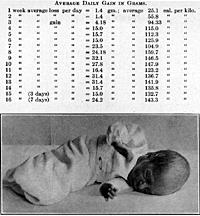
|
Fig. 126.-Baby Ann C. Age, eighteen days.
|
|
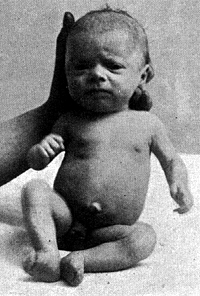
|
Fig. 127.-Baby Ann C. Age, one hundred and thirty-six
days.
|
|
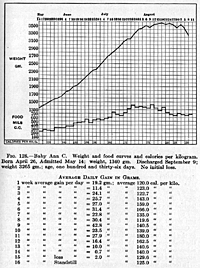
|
Fig. 128.-Baby Ann C. Weight and food curves and calories
per kilogram. Born April 26, Admitted May 14; weight, 1340
gm. Discharged September 9; weight 3265 gm.; age, one
hundred and thirty-six days. No initial loss.
|
|
|
Fig. 129. -- Utensils needed for artificial feeding:
Double boiler (small), pan, funnel, bottle-brush, 250-cc
(8-oz.) graduated glass or pitcher, six nursing bottles and
rack, paper caps for bottles (sterile), nipples, milk,
sugar, flour, milk of magnesia, citrate of soda, tablespoon,
dairy thermometer, vegetable mill.
|
|
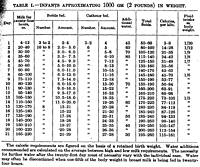
|
Table 1.
|
|
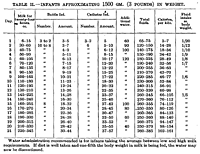
|
Table 2.
|
|
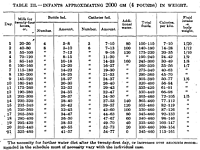
|
Table 3.
|
|
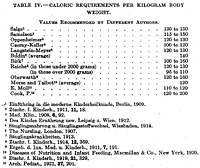
|
Table 4.
|
[1] As there are no short catheters marked
in the metric system on the market it is advisable to mark several
for ward use between 12 and 20 em, the chin at right angles to the
body. The lower end is seen about 1 cm. above the cardia in A, Fig.
101.
Return to the Hess Contents Page
Created 10/8/2002 / Last modified 10/8/2002
Copyright © 2002 Neonatology on the Web / webmaster@neonatology.net































